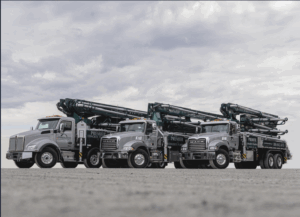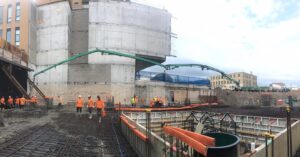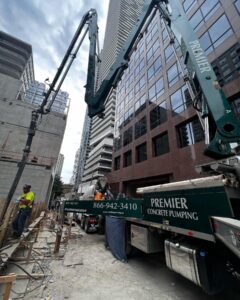Concrete pumping on complex job sites requires careful planning, clear communication, and the right equipment. As a general contractor, ensuring your concrete pump setup is efficient and safe can save time, reduce costs, and prevent costly delays. At Premier Concrete Pumping, with years of experience in ICI, residential, infrastructure, and large remote projects across the GTA, we’ve developed proven strategies to help you navigate even the most challenging sites.
Whether you’re coordinating a high-rise foundation, a tight residential backyard pour, or a sprawling infrastructure project, understanding how to prepare your site and work with your concrete pumping team is essential. This guide walks you through the key considerations and practical steps for a successful pump setup, drawing on real-world insights and industry best practices.
Prioritize Safety Above All
Safety is the foundation of every successful concrete pump operation, especially on complex sites where multiple teams, equipment, and materials converge. It’s not just about the pump operator; safety extends to ready-mix drivers, crew members working at the hose end, and everyone on site. Ensuring all personnel are trained, aware of potential hazards, and understand their roles is critical.
Before the pour, communicate clearly with everyone involved. New workers should be briefed on what to expect and where to stand to avoid hazards. Coordination prevents accidents such as someone moving a pipe into an unsafe position while another worker is in harm’s way. For detailed insights on safety protocols, visit our Health & Safety page.
Assess Site Conditions and Accessibility
A thorough site assessment helps identify any obstructions that might impact pump placement or concrete delivery. Large trees, machinery, overhead power lines, and site layout all influence how and where the pump and concrete trucks can be positioned. Boom pumps require space for outriggers and boom articulation, so clearing space or rearranging equipment may be necessary.
For residential projects with tight driveways or backyards, like custom homes or subdivisions, our operators may need to place the boom over or around the structure to reach the pour location. When overhead electrical wires are nearby, safety regulations limit how close the boom can operate. In some cases, a site visit is essential to determine feasibility and safe setup.
On jobs with live rail lines, overhead wires, or extremely tight work zones, we use advanced range limiting systems to maintain full control of the boom and prevent overreach — learn more about our approach to safe concrete pumping near railways.
If you’re interested in exploring which boom pump fits your project needs based on site constraints, check out our Boom Pump Selector Tool.
Consider Weather and Material Factors
Weather plays a significant role in planning concrete pumping. Rain often causes cancellations because excess water can weaken concrete and create surface defects that require costly repairs. Conversely, high temperatures generally don’t halt pours, but the concrete mix may need adjustments to prevent premature setting.
Winter pours require special additives, such as a winter-ready mix, to maintain concrete stability and strength despite cold temperatures. Planning pours according to weather conditions and material specifications is vital to project success. Learn more about advanced mixes and trends on our 2025 Concrete Pumping Trends page.
Prepare the Site for Efficient Pumping
To ensure a smooth setup, confirm that all forms are complete and inspected before the pump arrives. Remove any obstructions that could hinder equipment or truck access. Knowing the concrete delivery schedule ahead of time allows the pump operator and ready-mix driver to coordinate their arrival and minimize wait times.
Discuss washout options with your concrete pumping provider. Excess concrete must be cleaned out of the pump lines after the pour, which requires a designated washout area. For large subdivision projects, washout on-site is usually feasible. For smaller residential jobs, operators may transport excess concrete to approved washout locations or use washout bags, which are sometimes offered at an additional cost. For more details on our equipment and support, visit our Our Equipment page.
Communication and Coordination Are Key
Complex job sites often involve multiple contractors, trades, and logistics. Keeping an open line of communication with the pump operator, site manager, ready-mix supplier, and labor crew is essential. This coordination prevents misunderstandings, ensures safety, and allows real-time adjustments during the pour.
If conditions change unexpectedly, such as weather or site layout, your concrete pumping partner should be able to adapt quickly and advise on alternative setups or equipment. At Premier Concrete Pumping, our trained operators and project managers provide that flexibility, whether you’re working on an ICI project, infrastructure, or residential foundation. Learn more about our full range of services on our Services Overview page.
Final Thoughts: Planning Leads to Success
Proper planning for your concrete pump setup on complex job sites protects your timeline, budget, and quality. Taking the time to assess safety, site conditions, weather, and communication needs helps avoid common pitfalls and ensures the concrete is placed accurately and efficiently.
If you’re preparing for a complex pour and want expert guidance, Premier Concrete Pumping is here to help. Contact us today or explore our Contact Page to discuss your project needs and get a tailored quote.



